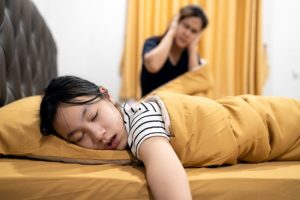Childhood Sleep Apnea & Its Consequences for Brain Development
August 11, 2017

When we think of sleep apnea, the sufferers that often come to mind are mature adults. And that certainly is the case, as it is now estimated that 26 percent of adults between the ages of 30 and 70 have sleep apnea, according to the American Academy of Sleep Medicine. But there are two other age groups that can be affected by disordered breathing during sleep: young children and adolescents. While the cases are less frequent, untreated sleep apnea during childhood can have serious, far-reaching consequences that follow into adulthood.
Childhood Sleep Apnea and the High Risk for ADHD
More common than is generally recognized, sleep apnea affects between one to four percent of children, usually from the ages of two to six.
We’ve discussed new research that links sleep disordered breathing to certain brain diseases, such as dementia and Alzheimer’s. Turns out, similar neurological damage is evident in children with sleep apnea. Research has found that kids with sleep disordered breathing are at minimum 40 percent more likely to develop behavioral problems – the most common issues being associated with ADHD.
In one study of 263 children ages six to eleven, children with incident sleep apnea as well as persistent sleep apnea were compared to children with no breathing issues during sleep. When analyzed next to children without sleep apnea, kids with incident sleep apnea were found to be at a four to five times higher risk of developing behavioral issues. Those with persistent sleep apnea were at a six times higher risk.
As recorded by their parents, children with sleep disordered breathing were more inclined to display the following behavioral problems:
- Attention issues
- Disruptive behaviors
- Hyperactivity
- Problems with social competency
- Difficulty maintaining self-care
- Issues with communication
Results showed that those with persistent sleep apnea were found to be seven times more likely to have parent-documented behavioral problems. They were also three times more likely to earn grades of C or under in school.
Adolescents
Tremendous hormone shifts and rapid brain development means that teenagers require a lot of sleep. Nine hours is considered the minimum – but most adolescents don’t get nearly that much sleep due to the stresses of school, social calendars, and natural changes to the body’s circadian rhythm (or internal clock) at that age.
Sleep deprivation can also be caused by adolescent sleep apnea. Even if your teenager has been “sleeping all night,” the reality is that sleep apnea may be resulting four full hours of sleep or less. Repeatedly waking up throughout the night wrecks rapidly changing hormones, and your teen may become more prone to a series of negative side effects, including obesity, worsened mood swings, and depression. Chronic sleep deprivation has even been known to trigger serious depression in young adults that are already predisposed to it.
Research supports that many of the behaviors we often dismiss as “teen angst” – moodiness, irritability, and reckless behavior – may actually be due to a chronic lack of sleep. Between 60 and 70 percent of teenagers live within a borderline of severe sleep debt. This deprivation can affect every part of an adolescent’s brain when it comes to decision making, from the inability to control impulses to substance abuse and other risky behaviors.
Treatment Options
The best treatment for children and adolescents with sleep apnea will largely depend on the individual case. Deciding factors are often the child’s age and the severity of the apnea. In simple cases, enlarged tonsils and adenoids are a frequent cause, and removal of the tonsils will help return breathing to normal.
This procedure is not right or necessary for every child, however. In certain situations, like when the tonsils are too small to remove or more than a simple fix is needed, other methods may prove to be the best option. A sleep physician may recommend a CPAP machine for childhood sleep apnea, especially if the child is very young or their mouth and jaw are still developing. Oral appliances are also an effective treatment option, especially in patients whose facial bone growth is largely complete. Again, treatment options vary with each case. The Apnea Treatment Center says that oral devices have been used successfully in children as young as six.
Oral appliance therapies can be a great solution for teens who do not need tonsil removal and have a fully developed facial bone structure. Many teenagers feel embarrassed by a bulky CPAP machine. Smaller oral appliances can provide a solution that your teenager will actually wear, so they can enjoy all the benefits of uninterrupted sleep.
As always, it’s important to talk to a doctor about proper treatment options. If you believe your child or teenager has sleep apnea, Dr. Kent Smith at Sleep Dallas can help you find the right solution. He has dedicated more than 20 years of his career to researching, analyzing and developing proven techniques that work. Contact us today to schedule a free consultation with absolutely no obligations.
